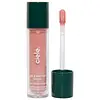What's inside
What's inside
 Key Ingredients
Key Ingredients

 Benefits
Benefits

 Concerns
Concerns

 Ingredients Side-by-side
Ingredients Side-by-side

Isododecane
EmollientHydrogenated Polyisobutene
EmollientHydrogenated Styrene/Isoprene Copolymer
Silica
AbrasiveTrimethylsiloxysilicate
EmollientMica
Cosmetic ColorantCaprylic/Capric Triglyceride
Masking1,2-Hexanediol
Skin ConditioningCaprylyl Glycol
EmollientTriethoxycaprylylsilane
Pentaerythrityl Tetra-Di-T-Butyl Hydroxyhydrocinnamate
AntioxidantCI 77891
Cosmetic ColorantIron Oxides
CI 42090
Cosmetic ColorantCI 15850
Cosmetic ColorantCI 45410
Cosmetic ColorantIsododecane, Hydrogenated Polyisobutene, Hydrogenated Styrene/Isoprene Copolymer, Silica, Trimethylsiloxysilicate, Mica, Caprylic/Capric Triglyceride, 1,2-Hexanediol, Caprylyl Glycol, Triethoxycaprylylsilane, Pentaerythrityl Tetra-Di-T-Butyl Hydroxyhydrocinnamate, CI 77891, Iron Oxides, CI 42090, CI 15850, CI 45410
Water
Skin ConditioningC26-28 Alkyl Dimethicone
Skin ConditioningCaprylyl Methicone
Skin ConditioningTridecyl Salicylate
Skin ConditioningGlycerin
HumectantC12-15 Alkyl Benzoate
AntimicrobialTitanium Dioxide
Cosmetic ColorantCI 77891
Cosmetic ColorantIsohexadecane
EmollientCaprylic/Capric Triglyceride
MaskingLauryl PEG-8 Dimethicone
Polymethylsilsesquioxane
Methylpropanediol
SolventDimethicone
EmollientDisteardimonium Hectorite
StabilisingSodium Chloride
MaskingAluminum Hydroxide
EmollientCI 16035
Cosmetic ColorantPolyglyceryl-4 Diisostearate/Polyhydroxystearate/Sebacate
EmulsifyingSilica
AbrasiveCaprylyl Glycol
EmollientIron Oxides
CI 77491
Cosmetic ColorantAllantoin
Skin ConditioningPropylene Carbonate
SolventLecithin
EmollientBisabolol
MaskingPhenylpropanol
MaskingHydrogenated Lecithin
EmulsifyingCI 77499
Cosmetic ColorantTetrasodium Glutamate Diacetate
Sodium Sulfate
Sodium Hydroxide
BufferingWater, C26-28 Alkyl Dimethicone, Caprylyl Methicone, Tridecyl Salicylate, Glycerin, C12-15 Alkyl Benzoate, Titanium Dioxide, CI 77891, Isohexadecane, Caprylic/Capric Triglyceride, Lauryl PEG-8 Dimethicone, Polymethylsilsesquioxane, Methylpropanediol, Dimethicone, Disteardimonium Hectorite, Sodium Chloride, Aluminum Hydroxide, CI 16035, Polyglyceryl-4 Diisostearate/Polyhydroxystearate/Sebacate, Silica, Caprylyl Glycol, Iron Oxides, CI 77491, Allantoin, Propylene Carbonate, Lecithin, Bisabolol, Phenylpropanol, Hydrogenated Lecithin, CI 77499, Tetrasodium Glutamate Diacetate, Sodium Sulfate, Sodium Hydroxide
 Reviews
Reviews

Ingredients Explained
These ingredients are found in both products.
Ingredients higher up in an ingredient list are typically present in a larger amount.
This ingredient is an emollient, solvent, and texture enhancer. It is considered a skin-softener by helping the skin prevent moisture loss.
It helps thicken a product's formula and makes it easier to spread by dissolving clumping compounds.
Caprylic Triglyceride is made by combining glycerin with coconut oil, forming a clear liquid.
While there is an assumption Caprylic Triglyceride can clog pores due to it being derived from coconut oil, there is no research supporting this.
Learn more about Caprylic/Capric TriglycerideCaprylyl Glycol is a humectant and emollient, meaning it attracts and preserves moisture.
It is a common ingredient in many products, especially those designed to hydrate skin. The primary benefits are retaining moisture, skin softening, and promoting a healthy skin barrier.
Though Caprylyl Glycol is an alcohol derived from fatty acids, it is not the kind that can dry out skin.
This ingredient is also used as a preservative to extend the life of products. It has slight antimicrobial properties.
Learn more about Caprylyl GlycolCi 77891 is a white pigment from Titanium dioxide. It is naturally found in minerals such as rutile and ilmenite.
It's main function is to add a white color to cosmetics. It can also be mixed with other colors to create different shades.
Ci 77891 is commonly found in sunscreens due to its ability to block UV rays.
Learn more about CI 77891Silica, also known as silicon dioxide, is a naturally occurring mineral. It is used as a fine, spherical, and porous powder in cosmetics.
Though it has exfoliant properties, the function of silica varies depending on the product.
The unique structure of silica enhances the spreadability and adds smoothness, making it a great texture enhancer.
It is also used as an active carrier, emulsifier, and mattifier due to its ability to absorb excess oil.
In some products, tiny microneedles called spicules are made from silica or hydrolyzed sponge. When you rub them in, they lightly polish away dead skin layers and enhance the penetration of active ingredients.
Learn more about SilicaThis ingredient is a combination of red, black, and yellow iron oxide pigments. This combination of colors is usually found in foundation, because it results in a "skin" color.